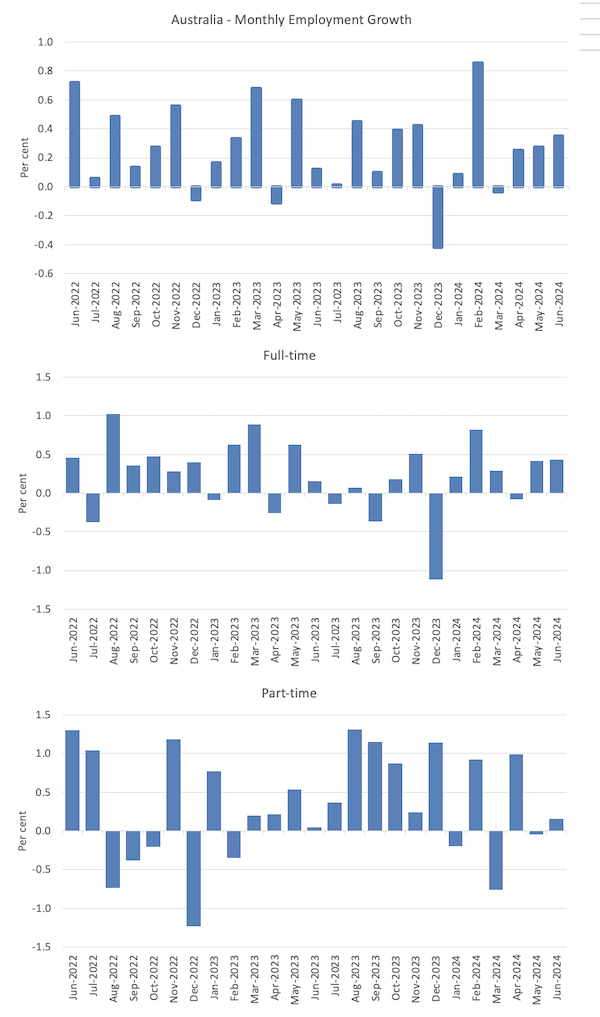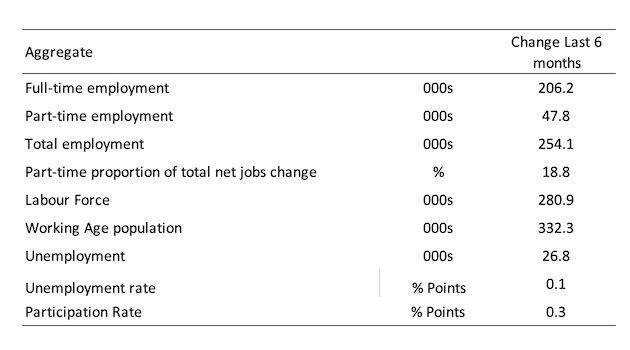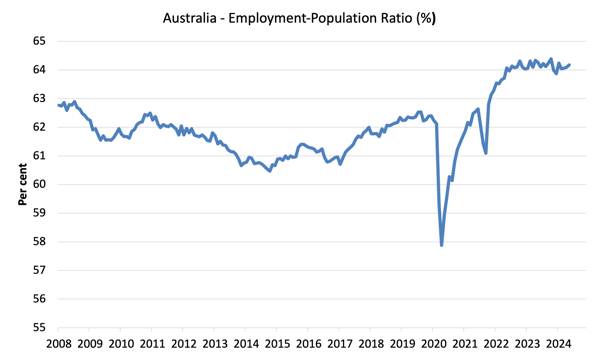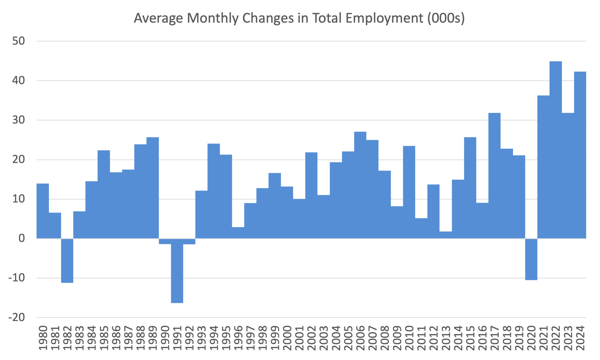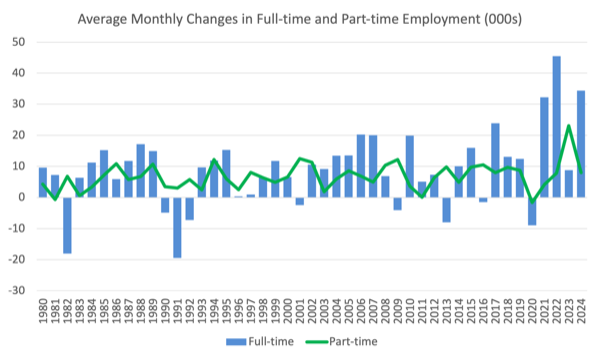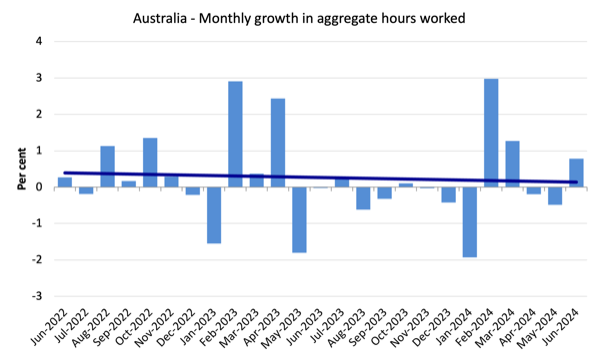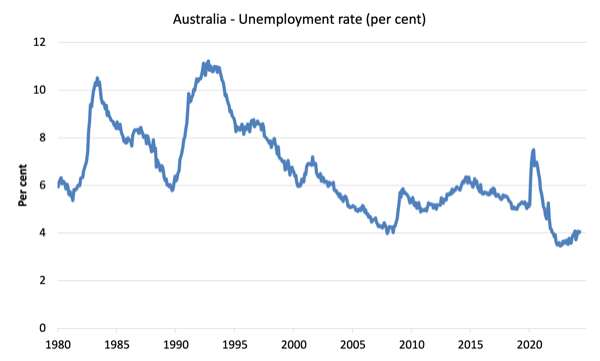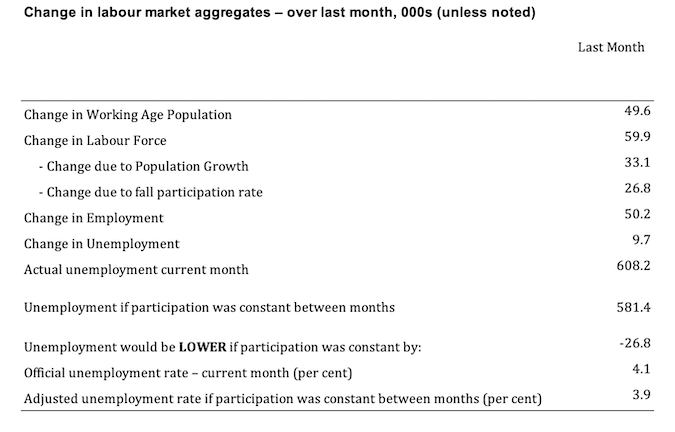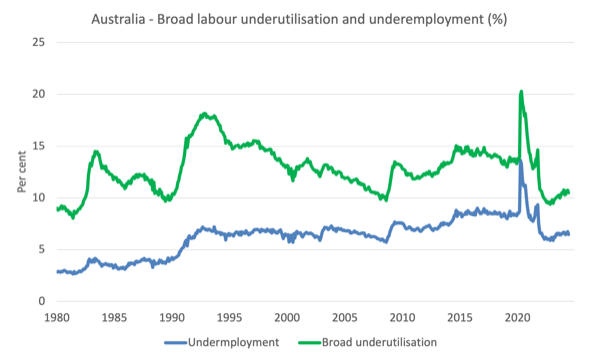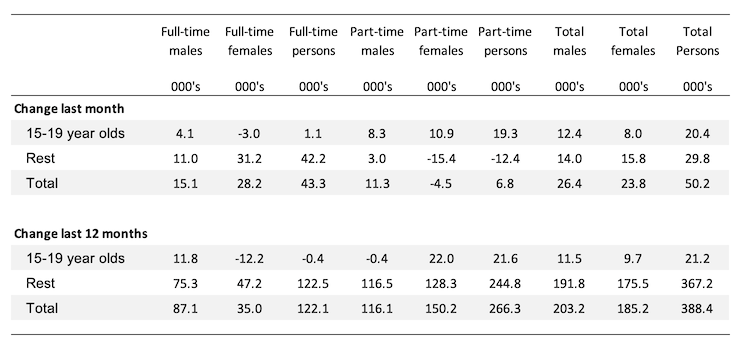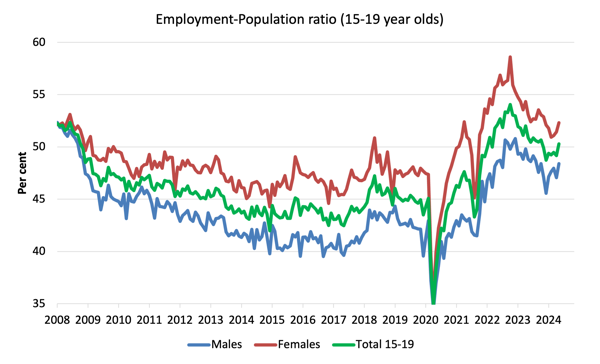[ad_1]
As we speak (July 18, 2024), the Australian Bureau of Statistics launched the newest – Labour Pressure, Australia – for June 2024, which reveals that the labour outlook has improved considerably from the final a number of months of plodding alongside undecided which solution to flip. Whereas it has been tough to make any definitive conclusions about the place the labour market goes primarily based on the information from the previous few months, the June knowledge means that the route is up fairly than down. With each employment development and participation rising, unemployment rose barely however that may be a signal of an bettering labour market outlook fairly than the alternative when unemployment rises on the again of a falling participation charge. The official unemployment was 4.1 per cent, a modest rise over the month, however would have truly fallen to three.9 per cent had the participation charge not risen. Employment development was stronger and targeting full-time work with month-to-month hours labored rising. Because of this, underemployment and broad labour underutilisation fell – one other good end result. However we must always not disregard the truth that there may be now 10.5 per cent of the working age inhabitants (1.6 million folks) who can be found and prepared however can’t discover sufficient work – both unemployed or underemployed and that proportion is growing. Australia shouldn’t be close to full employment regardless of the claims by the mainstream commentators and it’s onerous to characterise this as a ‘tight’ labour market.
The abstract ABS Labour Pressure (seasonally adjusted) estimates for June 2024 are:
- Employment rose 50,200 (0.3 per cent) – full-time employment elevated by 43.3 thousand and part-time employment elevated by 6.8 thousand. Half-time share of complete was 30.6 per cent.
- Unemployment rose 9,700 to 608,200 individuals.
- The official unemployment charge rose 0.1 level to 4.1 per cent.
- The participation charge rose 0.1 level to 66.9 per cent.
- The employment-population ratio rose 0.1 level to 64.2 per cent.
- Mixture month-to-month hours rose 15 million (0.8 per cent).
- Underemployment charge fell 0.3 factors to six.5 per cent – underemployment fell by 38.7 thousand. General there are 969.4 thousand underemployed staff. The overall labour underutilisation charge (unemployment plus underemployment) fell 0.2 factors to 10.5 per cent. There have been a complete of 1,577.6 thousand staff both unemployed or underemployed.
Within the ABS Media Launch – Unemployment and participation charges rise in June – the ABS famous that:
The seasonally adjusted unemployment charge rose by lower than 0.1 proportion level to 4.1 per cent in June …
The participation charge in June was solely 0.1 proportion level decrease than the historic excessive of 67.0 per cent in November 2023. The employment-to-population ratio rose by 0.1 proportion level to 64.2 per cent, which was additionally near its historic excessive of 64.4 per cent in November 2023 …
In keeping with the rise in hours labored, the seasonally adjusted underemployment charge fell 0.3 proportion factors to six.5 per cent. The underemployment charge was 0.1 proportion level decrease than June final yr, and a couple of.3 proportion factors decrease than March 2020.
The underutilisation charge, which mixes the unemployment and underemployment charges, additionally fell 0.2 proportion factors to 10.5 per cent. Whereas this was 0.4 proportion factors greater than June 2023, it was 3.4 proportion factors decrease than March 2020.
Basic conclusion:
1. Persevering with good indicators with employment development sturdy and drawing extra folks again into exercise (participation charge rising).
2. The dominance in full-time employment development this month is a strong signal.
3. The rising employment-population ratio is an efficient indicator that the labour market shouldn’t be tanking.
4. Unemployment barely greater – because of the rise in participation.
5. Sturdy full-time employment and hours labored development drove underemployment down.
Employment rose 50,200 (0.3 per cent) in June 2024
1. Full-time employment elevated by 43.3 thousand and part-time employment elevated by 6.8 thousand.
2. The employment-population ratio rose 0.1 level to 64.2 per cent.
The next graph present the month by month development in complete, full-time, and part-time employment for the 24 months to June 2024 utilizing seasonally adjusted knowledge.
The next desk offers an accounting abstract of the labour market efficiency over the past six months to offer an extended perspective that cuts by means of the month-to-month variability and offers a greater evaluation of the traits.
Given the variation within the labour power estimates, it’s generally helpful to look at the Employment-to-Inhabitants ratio (%) as a result of the underlying inhabitants estimates (denominator) are much less cyclical and topic to variation than the labour power estimates. That is an alternate measure of the robustness of exercise to the unemployment charge, which is delicate to these labour power swings.
The next graph reveals the Employment-to-Inhabitants ratio, since April 2008 (that’s, because the GFC).
The employment-to-population ratio remains to be demonstrating stability with minor fluctuations across the present stage.
For perspective, the next graph reveals the common month-to-month employment change for the calendar years from 1980 to 2024.
1. The common employment change over 2020 was -10.5 thousand which rose to 36.3 thousand in 2021 because the lockdowns eased.
2. For 2022, the common month-to-month change was 44.9 thousand, and for 2023, the common change was 31.9 thousand.
3. Thus far in 2024, the common month-to-month change is 42.3 thousand.
The next graph reveals the common month-to-month modifications in Full-time and Half-time employment in 1000’s since 1980.
Mixture month-to-month hours rose by 15 million hours (0.8 per cent)
The next graph reveals the month-to-month development (in per cent) over the past 48 months (with the pandemic restriction interval omitted).
The darkish linear line is a straightforward regression development of the month-to-month change.
Unemployment rose 9,700 to 608,200 individuals in June 2024
The very modest rise in unemployment and the unemployment charge was because of the rising participation charge (see beneath) as extra folks have been attracted into the labour power on the again of the stronger employment development.
The next graph reveals the nationwide unemployment charge from April 1980 to June 2024. The longer time-series helps body some perspective to what’s taking place at current.
What was the influence of the rising participation charge on unemployment in June 2024
The query is what would the unemployment charge have been, given the numerous employment development in June, if the participation charge had not risen and dragged extra staff in to the labour power?
Listed below are the calculations.
The labour power is a subset of the working-age inhabitants (these above 15 years previous). The proportion of the working-age inhabitants that constitutes the labour power is known as the labour power participation charge. Thus modifications within the labour power can influence on the official unemployment charge, and, in consequence, actions within the latter should be interpreted rigorously. A rising unemployment charge could not point out a recessing financial system.
The labour power can broaden because of common inhabitants development and/or will increase within the labour power participation charges (and vice versa).
The next Desk reveals the breakdown within the modifications to the principle aggregates (Labour Pressure, Employment and Unemployment) and the influence of the autumn within the participation charge.
The change within the labour power in June 2024 was the end result of two separate elements:
- The underlying inhabitants development added 33.1 thousand individuals to the labour power. The inhabitants development influence on the labour power combination is comparatively regular from month to month; and
- The rise within the participation charge meant that there have been 26.8 thousand MORE staff coming into the labour power (relative to what would have occurred had the participation charge remained unchanged).
- The web consequence was that the labour power fell by 59.9 thousand.
Evaluation:
1. If the participation charge had not have risen in June 2024, complete unemployment, given the present employment stage, would have been 581.4 thousand fairly than the official depend of 608.2 thousand as recorded by the ABS – a distinction of 26.8 thousand staff (the ‘participation impact’).
2. With out the rise within the participation charge, the official unemployment charge would have been 3.9 per cent (rounded) fairly than its present official worth of 4.1 per cent).
Broad labour underutilisation fell 0.2 factors in June 2024
1. Underemployment charge fell 0.3 factors to six.5 per cent – underemployment fell by 38.7 thousand.
2. General there are 969.4 thousand underemployed staff.
3. The overall labour underutilisation charge (unemployment plus underemployment) fell 0.2 factors to 10.5 per cent.
4. There have been a complete of 1,577.6 thousand staff both unemployed or underemployed.
The truth that there may be 10.5 per cent of staff who’re each obtainable and prepared to work which are with out work in a technique or one other (unemployed or underemployed) makes a mockery of claims by financial commentators and coverage officers that Australia is close to full employment or that that is a particularly tight labour market.
The next graph plots the seasonally-adjusted underemployment charge in Australia from April 1980 to the June 2024 (blue line) and the broad underutilisation charge over the identical interval (inexperienced line).
The distinction between the 2 strains is the unemployment charge.
Teenage labour market improves in June 2024
General teenage employment fell by 20.4 thousand – full-time employment rose by 1.1 thousand whereas part-time employment rose by 19.3 thousand.
The next Desk reveals the distribution of internet employment creation within the final month and the final 12 months by full-time/part-time standing and age/gender class (15-19 yr olds and the remainder).
To place the teenage employment state of affairs in a scale context (relative to their dimension within the inhabitants) the next graph reveals the Employment-Inhabitants ratios for males, females and complete 15-19 yr olds since July 2008.
You’ll be able to interpret this graph as depicting the change in employment relative to the underlying inhabitants of every cohort.
By way of the latest dynamics:
1. The male ratio rose by 1.3 factors over the month.
2. The feminine ratio rose 0.9 factors over the month.
3. The general teenage employment-population ratio rose 1.1 factors over the month.
Conclusion
My customary month-to-month warning: we at all times must watch out decoding month to month actions given the best way the Labour Pressure Survey is constructed and carried out.
My general evaluation is:
1. Whereas it has been tough to make any definitive conclusions about the place the labour market goes primarily based on the information from the previous few months, the June knowledge means that the route is up fairly than down.
2. With each employment development and participation rising, unemployment rose barely however that may be a signal of an bettering labour market outlook fairly than the alternative when uemployment rises on the again of a falling participation charge.
3. Employment development was stronger and targeting full-time work with month-to-month hours labored rising.
4. Because of this, underemployment and broad labour underutilisation fell – one other good end result.
4. However we must always not disregard the truth that there may be now 10.5 per cent of the working age inhabitants (1.6 million folks) who can be found and prepared however can’t discover sufficient work – both unemployed or underemployed and that proportion is growing.
7. Australia shouldn’t be close to full employment regardless of the claims by the mainstream commentators and it’s onerous to characterise this as a ‘tight’ labour market.
[ad_2]
